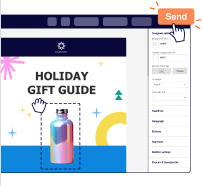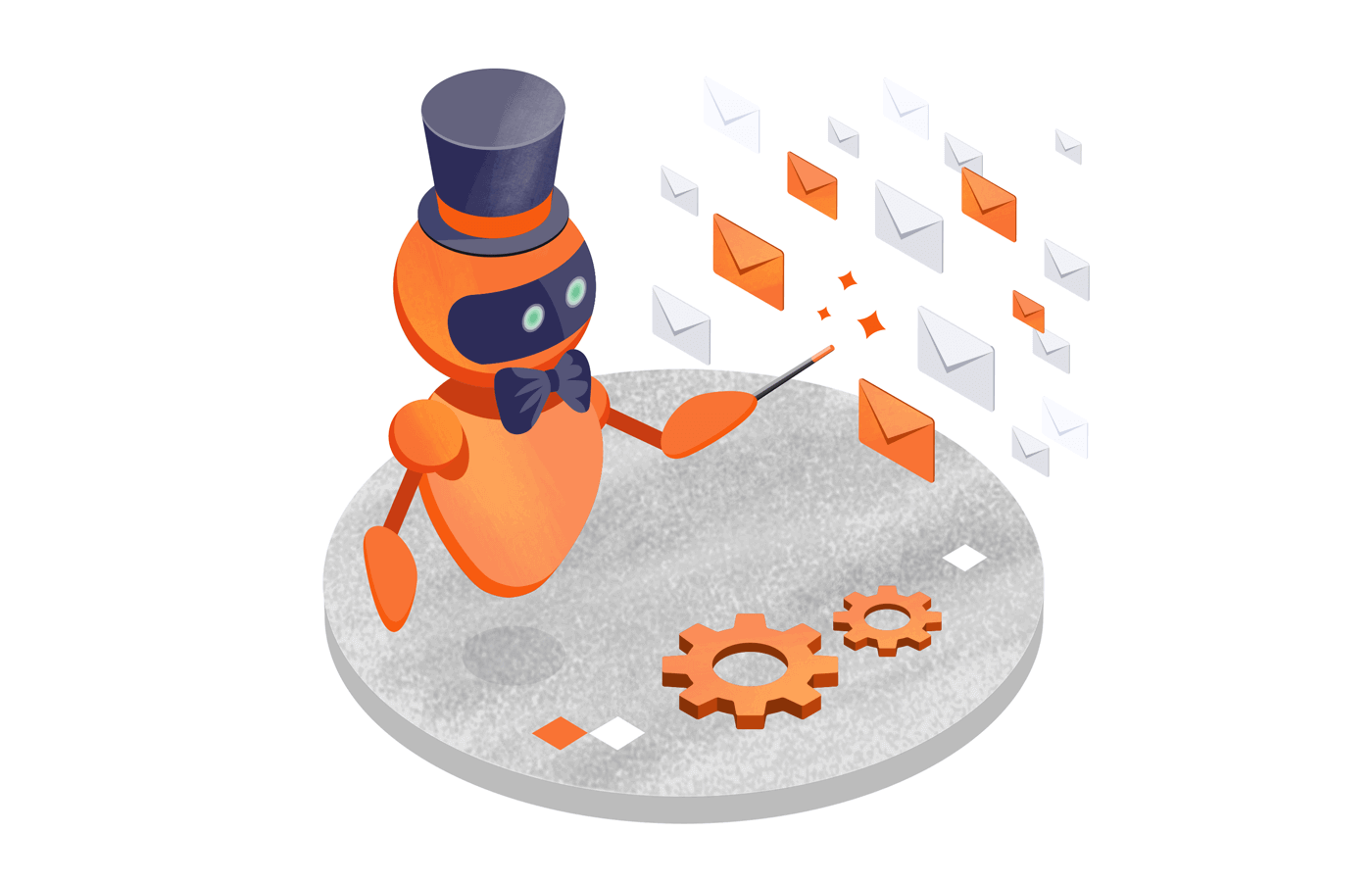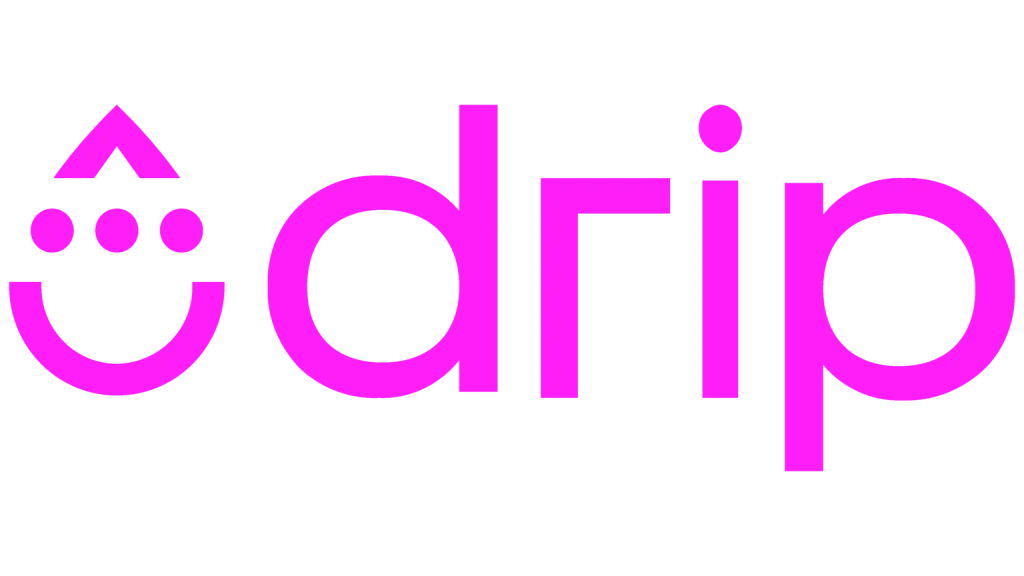Manually sending welcome emails in 2025? Or are you wasting hours building campaigns and still guessing if anyone clicked? Email automation is something you need.
After years of working in automation and testing more tools than we can count, we’ve figured out what works best for businesses.
In this guide, we’ll share the email marketing automation solutions we trust, why we recommend them, and how each one fits different business needs.
Let’s help you find the right tool to finally make email work on autopilot.
Disclaimer: This article evaluates different automated email software, including Sender, which our company owns. We present assessments based on research, industry standards, and user feedback. We selected these platforms after comparing their features, pricing, and performance. We don’t earn any commissions from links in this article.
What is Email Automation Software?
An email automation software automatically sends personalized messages based on user behaviors or triggers. It helps you schedule emails to go out at the right time.
Instead of manually sending emails, such a solution helps you set up email drip campaigns that deliver targeted messages step-by-step. You can use it to welcome subscribers, send abandoned cart reminders, or quick auto-responses.
The real magic? Your campaigns keep running seamlessly once you set them up. So, there’s less babysitting and fewer mistakes, and you have more time for other day-to-day tasks.
Key Features of Email Automation Software
When you’re comparing different email automation tools, you should consider all the features. It’s best to choose a solution with a feature set that simplifies your workflow and isn’t overwhelming.
Here’s what you should look for in an email marketing automation tool:
- Automated campaigns and drip sequences. The email marketing platform should have a drag-and-drop email builder for designing automated campaigns and drip sequences for nurturing leads, reengaging inactive customers;
- Segmentation and targeting. Advanced segmentation features will help you group subscribers based on their behaviors, preferences, or demographics for targeted emails;
- Personalization capabilities. Look for platforms with features like dynamic content based on browsing and purchase history to help create meaningful interactions with subscribers;
- Analytics and reporting. Reporting features should give you clarity about the performance and ROI of email campaigns. So, you always know what’s working, and when to optimize your email marketing efforts;
- A/B testing and optimization. Features like A/B testing for subject lines, content, send times, etc. will help you improve the effectiveness of your campaigns over time, and get better results;
- Integrations and API support. The software should seamlessly connect your email operations with your online store, CRM, and other marketing tools to keep your efforts unified and easy to manage;
- User-friendly interface and templates. A simple UI and ready-to-use templates will save you hours during campaign creation. Plus, it helps when you’re not that design or tech-savvy but still want to send professional-looking emails.
Top Email Automation Software – Quick Roundup
Choosing the right automated email marketing software can feel overwhelming, with so many options offering unique and new features.
To simplify things, we’ve rounded up the top-rated workflow automation platforms, highlighting what they’re best for, their standout features, and whether they offer a free plan. Check out this quick comparison to find the best automated email service for your business.
| Provider | Best for | Standout Feature | Free Plan |
| Sender | Advanced email automation | Premade workflows + drag-and-drop automation builder | Yes. Up to 2,500 subscribers |
| ActiveCampaign | Personalization and CRM email marketing automation features | Advanced segmentation | Limited-time free trial |
| Zoho Campaigns | Cross-functional teams | CRM-connected workflows | Yes, with basic features |
| HubSpot | Creating central hub for sales, CRM and marketing | Integrated CRM with marketing automation tool | Limited free tools only |
| Mailchimp | Building autoresponder sequences | Intuitive drag-and-drop editor | Yes, free for up to 500 contacts |
| Omnisend | Omnichannel campaigns | Multichannel marketing tools | Yes, with basic features |
| Drip | Specialized campaigns for ecommerce stores | Advanced behavioral triggers | 14-day free trial only |
| Kit | Creators and bloggers | Audience segmentation | Yes, with basic features |
| Klaviyo | Data-driven ecommerce marketing | Predictive analytics | Yes, free for up to 250 contacts |
| Postmark | Reliable transactional emails | Real-time deliverability tracking | No free plan |
| Constant Contact | Scheduled email management | Social media integrations | Limited-time free trial only |
11 Best Email Automation Software for Your Business
Now that you’ve got the basic idea, let’s look at each email marketing automation system in detail to help you find the one that will suit your requirements.
Here are our top picks based on our personal experience and tests.
Sender — Best for Personalized Email Journey
⭐️ Trusted by 180,000+ businesses worldwide
If you want powerful email automation without the steep price or complex learning curve, Sender is hard to beat. It’s built for marketers and founders who value personalization and performance, but don’t want to spend hours configuring workflows.
With behavior-based automation, dynamic content, and real-time segmentation, Sender helps you deliver targeted, timely messages that actually convert.
User Experience Ratings:
- Capterra: 4.7 /5.0
- Trustpilot: 4.8 /5.0
- G2: 4.5 /5.0

Sender is one of the few tools that balances depth with simplicity. Its visual automation builder is intuitive enough for beginners but also equally powerful to support complex flows like multi-step nurture sequences.
You can personalize emails down to user preferences or actions, without needing custom code. Combine that with product blocks and behavioral segmentation, and you’ve got everything you need to send emails that feel one-on-one, even at scale.
Even better, it doesn’t punish you for growing. Many features that are locked behind premium tiers elsewhere, like automation templates or segmentation, are available on the free plan. And when you get stuck? Use the live chat support that replies within seconds.
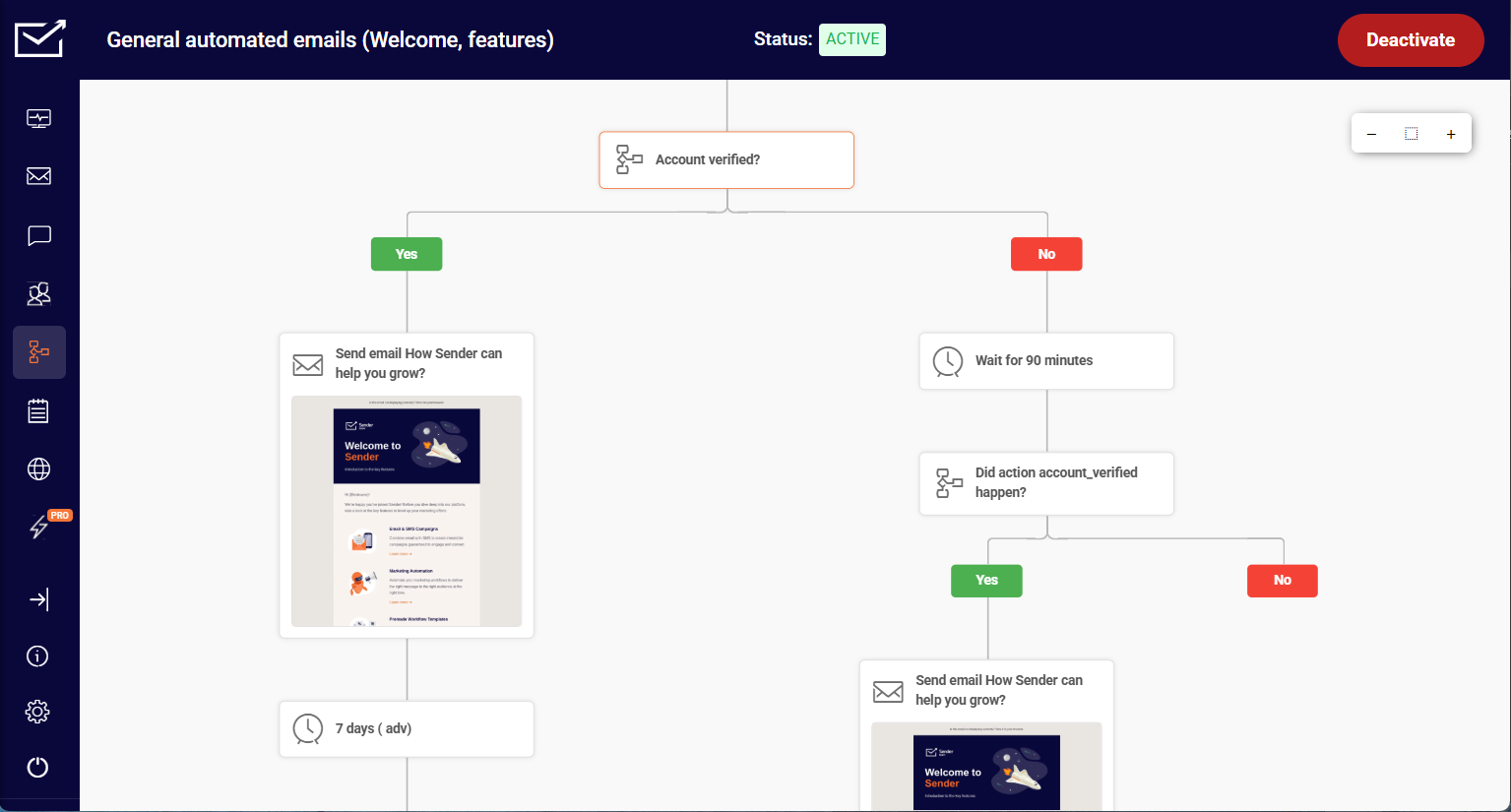
Standout Features
- Visual workflow builder. Build email flows with ease using prebuilt templates and drag-and-drop automation triggers;
- Dynamic content blocks. Personalize product and message content based on user behavior, in real-time;
- Omnichannel campaigns. Combine email and SMS in one workflow for higher engagement and conversion;
- Behavioral segmentation. Target users based on behavior, clicks, activity status, or engagement.
Use Cases
Sender is ideal for online businesses that pay attention to meaningful customer engagement through personalized email automation. Here are some use cases:
- Ecommerce stores. Automate personalized product recommendations, welcome emails, and abandoned cart email sequences;
- Service-based startups. Create targeted email marketing campaigns based on user actions, preferences, or subscription status;
- Content creators. Engage subscribers through automated email marketing newsletters and personalized updates triggered by reader behavior.
Our Experience with Sender
We set up a welcome email series for a small ecommerce client, along with cart abandonment sequences, and weekly promos—all in under an hour. The result? A 17% cart recovery rate within the first 30 days, with minimal hand-holding needed after setup.
Another highlight is how flexible the automation builder feels. Unlike clunky editors in other tools, we could easily tweak flows mid-campaign—adding conditions, delays, or SMS actions without restarting. It felt like the tool was made for people who love simplicity and power.
Pricing
Sender starts at just $7/month for 1,000 subscribers and 12,000 emails. The forever free plan is surprisingly generous and offers up to 15,000 emails for 2,500 subscribers. Compared to other tools on this list, you get all the premium functionality at a fraction of the cost.
ActiveCampaign — Advanced Personalization and Automation Tools
If you’re scaling fast and need a platform that keeps up, ActiveCampaign delivers. It’s a powerful automation engine paired with a built-in email marketing automation CRM.
From complex workflows to hyper-personalized campaigns, it gives growing teams the control they need to run high-converting, behavior-based journeys across the entire customer lifecycle.
User Experience Ratings:
- Capterra: 4.6 /5.0
- Trustpilot: 3.1 /5.0
- G2: 4.5 /5.0
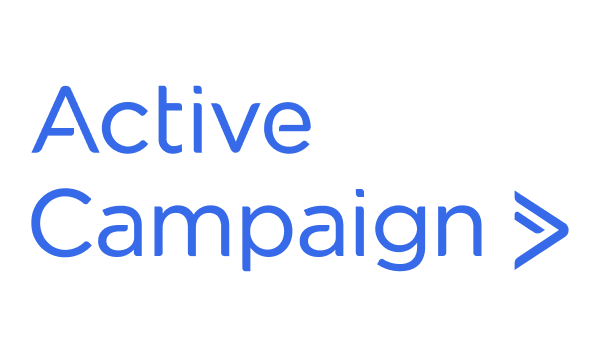
We used ActiveCampaign and loved the in-depth automation. You get granular control over the user journey, branching, lead scoring, and can track browsing behavior to trigger an automated email system at just the right time.
In our experience, it shines when your marketing and sales efforts need to sync. We’ve built workflows that not only nurture leads but hand them off to the right sales rep with full context.
However, if you’re on the entry plan, some key features like lead scoring and deep automation aren’t unlocked, you’ll need the Plus plan to make the most of it. Also worth noting: the automation builder is incredibly flexible, but not exactly beginner-friendly. Teams with limited experience may face a steep learning curve.

Standout Features
- Behavior-based segmentation. Target users by actions, time delays, page visits, or engagement scores in real-time;
- CRM + email fusion. Unified platform to manage contacts, deals, and email automation under one roof;
- AI workflows. Smart prompts help you build complex flows based on your goal and industry;
- Lead scoring engine. Score leads based on email activity, site behavior, and CRM touchpoints for better conversions.
Use Cases
ActiveCampaign is best for growing businesses that need high-level automation in their sales platform. Here are some use cases we could think of:
- B2B SaaS companies. Automate lead nurturing and handoff to sales using CRM data;
- Service businesses. Personalize email journeys based on booking or inquiry behavior;
- Ecommerce scaleups. Use dynamic content and scoring to boost the lifetime value of shoppers.
Our Experience with ActiveCampaign
We implemented ActiveCampaign for a mid-sized SaaS client that struggled with lead qualification. By setting up site tracking, lead scoring, and CRM-connected workflows, we created a scoring model that auto-routed high-intent leads to sales. Within 45 days, their demo booking rate increased by 26%.
Another insight? Their built-in email builder isn’t as flashy as some newer tools—but it’s reliable. And the CRM automation feels like a hidden superpower, especially when used to trigger follow-ups or internal alerts based on contact activity.
Pricing
Plans start at $15/month for up to 1,000 contacts, but real value kicks in from the Plus plan, which starts at $49/month. That’s where lead scoring, deeper integrations, and CRM features unlock.
They also offer a 14-day free trial, which we recommend using to test full automation potential before committing.
We moved to ActiveCampaign from two separate systems — one a CRM and one an email marketing provider. Having the capabilities for both of these in one solution has been amazing.
— DJ from G2
Zoho — Budget-Friendly Automation for Growing Teams
Zoho offers a smart, affordable option for small teams that want serious features without heavy costs.
Zoho email marketing automation gives you everything needed to get started—segmentation, workflows, and essential integrations to streamline your marketing ops.
User Experience Ratings:
- Capterra: 4.0 / 5.0
- Trustpilot: 4.1 / 5.0
- G2: 4.1 / 5.0

You can set up Zoho Campaigns alongside Zoho CRM and build email workflows based on CRM stages, lead scores, or even web activity.
We tried setting up a lead nurture journey that triggered different email sequences depending on the CRM tag. We noticed that this can lead to an improvement in conversion-to-demo bookings flows.
While the UI isn’t the slickest, it’s functional. Once you’re inside, features like A/B testing, autoresponders, and detailed reports are all just a few clicks away. And if your team’s already using Zoho tools for sales, support, or finance, it’s a great add-on.
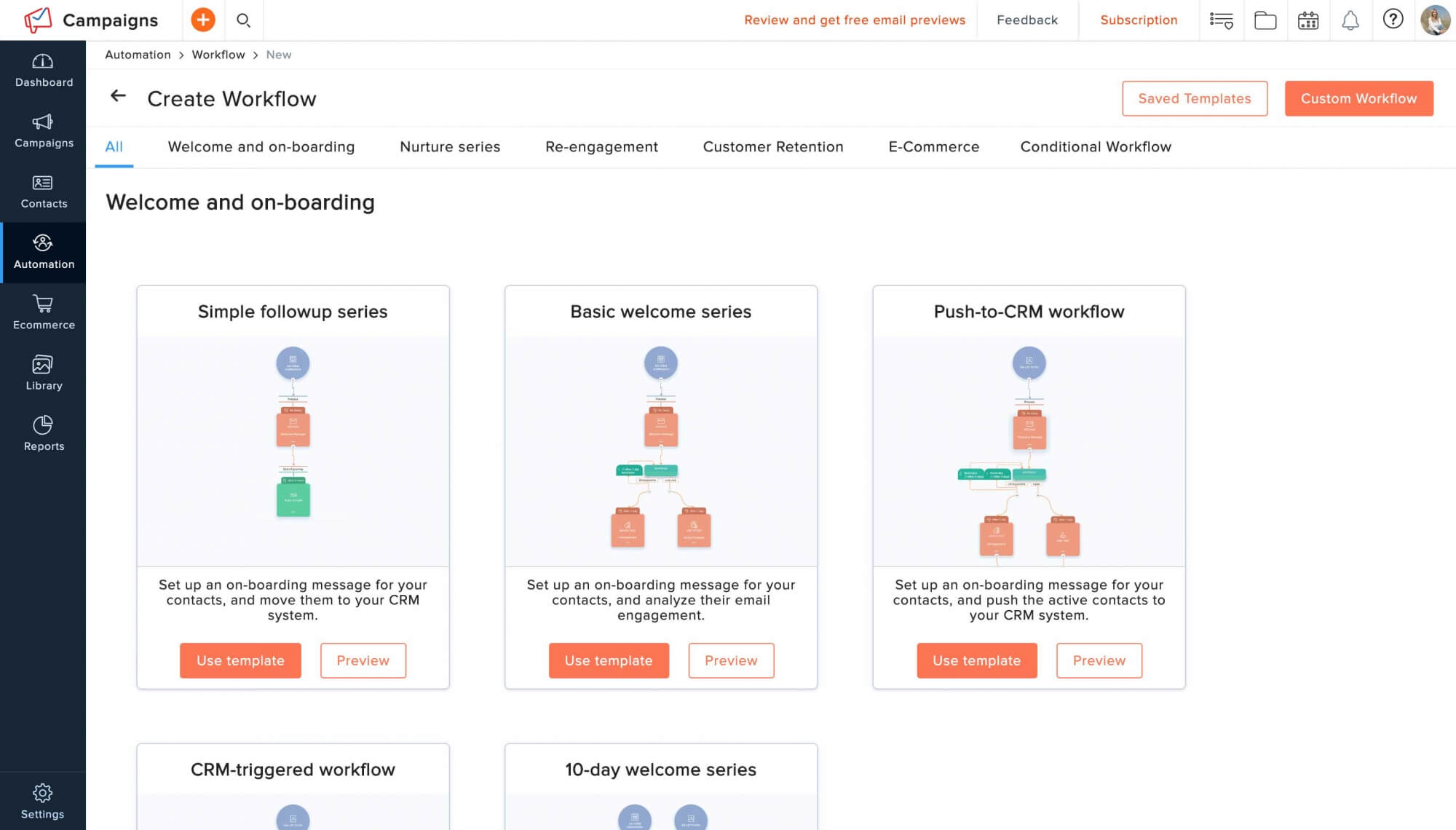
Standout Features
- CRM-connected workflows. Trigger automations from CRM data like lead stage, score, or contact activity;
- Dynamic content & tags. Personalize email content based on user behavior, geography, or past interactions;
- Pre-designed sequences. Set up onboarding, event reminders, or drip campaigns without starting from scratch;
- Multi-list segmentation. Manage different audiences with flexible customer list control and tagging features.
Use Case by Industry
Zoho fits best where tight budgets meet growing complexity, especially for cross-functional teams. Here are some rewarding use cases:
- Service providers. Nurture leads post-inquiry and follow up on consultations through CRM-integrated emails;
- B2B agencies. Automate onboarding, feedback collection, and project updates from one centralized dashboard;
- Education & training. Deliver course materials, webinar reminders, and personalized follow-ups at scale.
Our Experience with Zoho
One of the things we tested on Zoho was to set up a 5-step welcome flow with dynamic content blocks based on the subscriber’s preferences. The process felt smooth, required no extra plugins.
What we liked was how integrated and seamless everything felt. Zoho’s ecosystem led to fewer jumps between tabs and more work done in less time.
Pricing
Zoho Campaigns’ pricing page says that the paid plans start at $7/month for up to 1,000 subscribers with scalable plans as you grow.
There’s also a free plan with basic features, which is great for testing the waters. If you’re already using Zoho CRM or other tools, adding Campaigns to the mix is a good idea.
‘Zoho offers a robust, customizable interface that integrates seamlessly with our digital marketing ecosystem. The automation workflows, lead scoring, and multichannel communication tools enable us to deliver personalized experiences at scale.’
HubSpot — Comprehensive Marketing Automation Platform
HubSpot is an all in one solution that offers a fully functional CRM with email automation features. Its user-friendly interface is designed for businesses looking to centralize their tools.
User Experience Ratings:
- Capterra: 4.5 /5.0
- Trustpilot: 2.4 /5.0
- G2: 4.4 /5.0
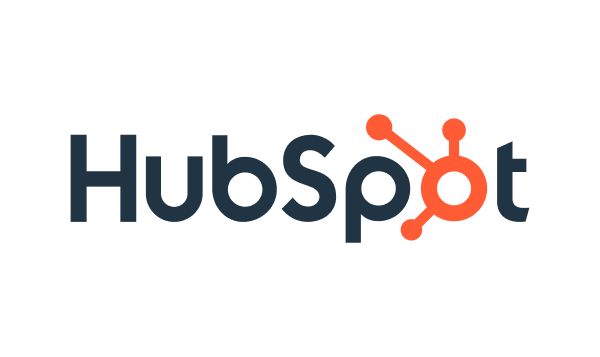
With HubSpot, you don’t just automate emails—you align marketing, sales, and customer service from a single dashboard. From lead capture to pipeline management, everything is interconnected.
In our experience, HubSpot’s automation features really shine when used beyond email. You can trigger internal tasks, score leads based on behavior, automate CRM workflows, and even route contacts to sales.
However, the entry-level plan limits advanced automation. Most users end up upgrading to unlock features like lifecycle stage automation and custom branching logic.
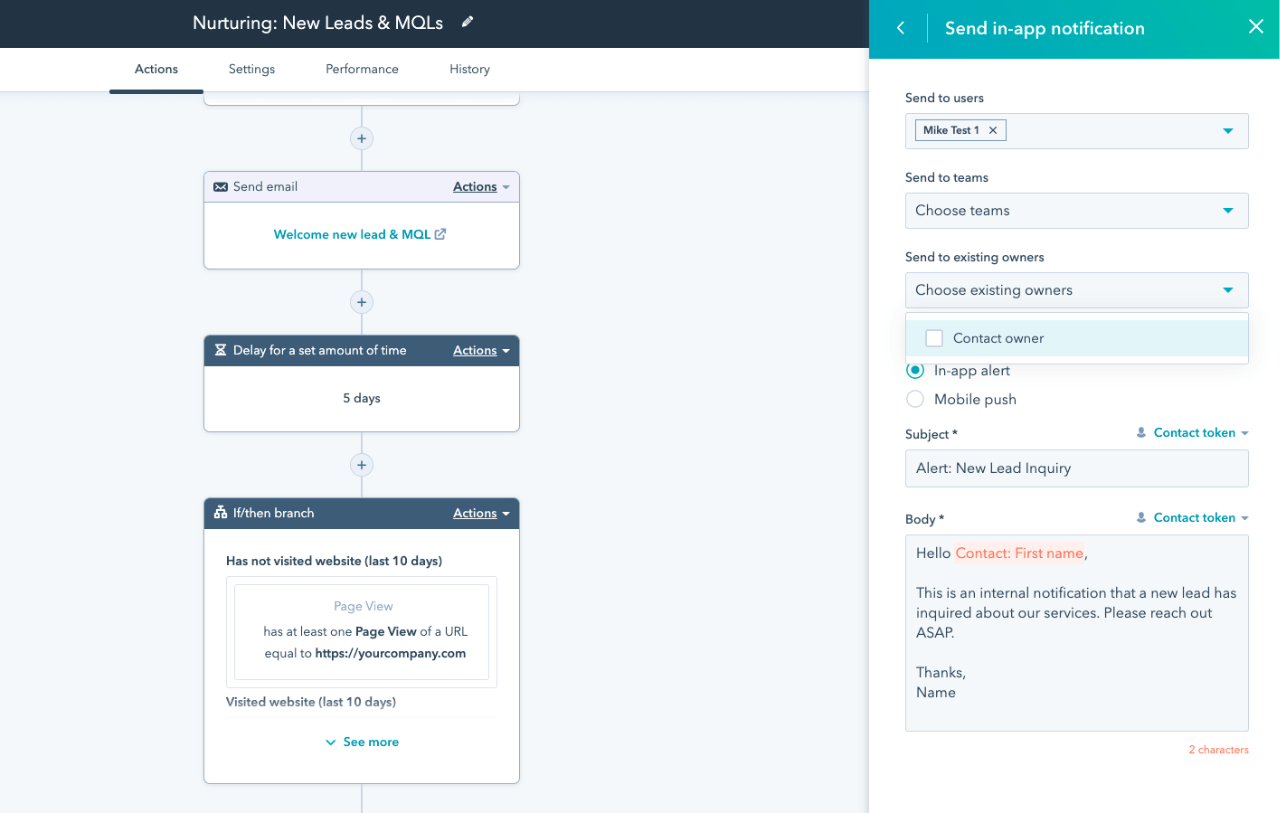
Standout Features
- Unified CRM and automation. One dashboard to manage contacts, automate follow-ups, and track deals seamlessly;
- Lead scoring engine. Score leads based on email opens, form fills, and deal activity to focus on high-value contacts;
- Landing pages & forms. Create conversion-friendly pages and connect them directly to email workflows;
- Cross-platform integration. Connect with over 1,500 tools across its sales, support, and marketing hub for automation.
Use Cases
HubSpot is good for large-scale businesses needing an all-in-one platform that ties marketing, sales, operations, and customer support together. Here are the ideal users:
- B2B service providers. Automate lead qualification and email nurturing based on CRM data;
- Agencies. Centralize email, landing pages, and contact management in one dashboard;
- Sales-driven businesses. Build complete sales funnels with email automation and customer tracking.
Our Experience with HubSpot
We saw how HubSpot can make your marketing, sales, and operations completely integrated. It offers unified contact views, automated lead rotation, which leads to faster sales response time. Also, it helps marketing teams that can use pre-built templates to launch nurture campaigns in hours instead of days.
HubSpot’s funnel builder and automation dashboard felt like a control center—helpful for visualizing customer journeys at scale. The trade-off is pricing; the more powerful features are locked behind higher plans.
Pricing
HubSpot starts at $18/month for 1,000 marketing contacts, and also offers a free plan with CRM. To unlock its full automation engine, including lead scoring, smart branching, and advanced CRM workflows, you’ll need a paid plan, which is not the cheapest option, but it can be fruitful if you’ve got a large team.
Overall I have a great experience with Hubspot Marketing. I do a mixture of operations and marketing duties during my day and my experience in the marketing module has helped me in areas of operations as well. The social content scheduling aspect of it has been seamless!
— Allie from Capterra
Also read: 10 Best All-in-One Marketing Platforms Compared (2025)
Mailchimp — Excellent for Building Autoresponder Sequences
Mailchimp offers a simple platform for email campaign management to beginners. While it’s widely recognized for its user-friendly newsletter creation, Mailchimp also offers email automation capabilities.
User Experience Ratings:
- Capterra: 4.5 /5.0
- Trustpilot: 2.6 /5.0
- G2: 4.3 /5.0

In our experience, Mailchimp stands out for how simple its approach to automation is. You don’t need to understand complex workflows or marketing jargon. Just pick a trigger, like a new signup or a link click, and the visual builder takes care of the rest.
While it’s not the most advanced or more affordable tool, it can help you get started quickly if you want to set up simple automations for a small email list. There’s also a form and landing page builder to help with landing page creation. It’s not without limitations though.
More advanced automations, like behavior-based segmentation or multi-branch flows, are better handled by other tools. Plus, other tools are more affordable when it comes to scaling.
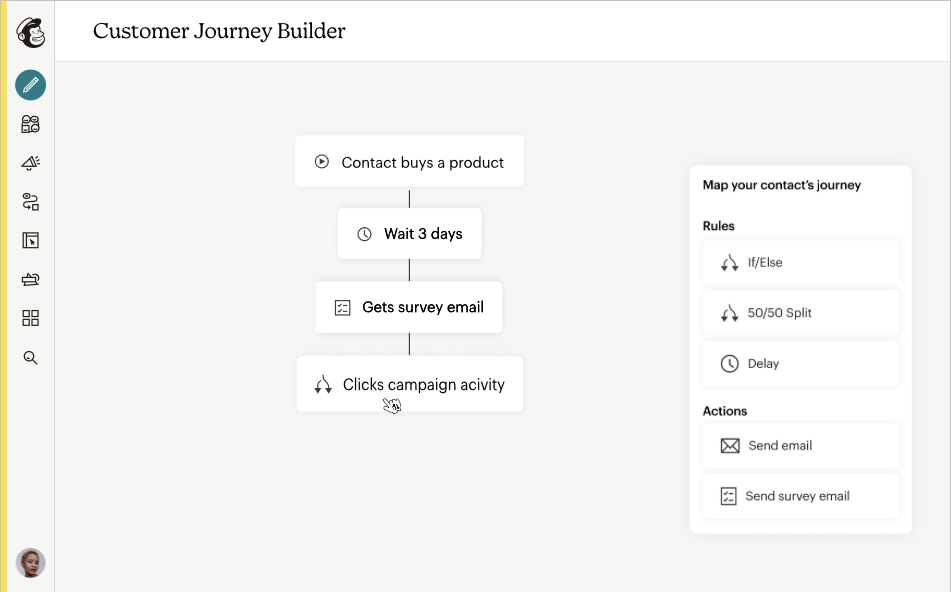
Standout Features
- Smart triggers setup. Automate sequences based on clicks, opens, purchases, or even site visits;
- Landing page builder. Design standalone pages for lead gen or promos without extra tools;
- Scheduling tools. Block calendars, send auto-reminders, and manage appointments within your workflow;
- All-in-one dashboard. Get performance analytics, email builder, and campaign management in one simple view.
Use Cases
Mailchimp is a great choice for businesses that want an easy way to automate their communication without technical skills. Here’s how businesses can use Mailchimp:
- Small businesses. Build automated welcome and nurture sequences with a drag-and-drop editor;
- Ecommerce brands. Send product recommendations, cart recovery, and order confirmation emails;
- Content creators. Automate weekly newsletters and updates based on user engagement and preferences.
Our Experience with Mailchimp
We’ve spent a lot of time testing Mailchimp and know its a good beginner tool. You can set up welcome email flows, post-purchase emails, and personalized thank you emails within an hour.
It has a simple interface with lots of help docs. But the problem with Mailchimp is how ‘restrictive’ it feels, even if you want to do something as simple as multiple segments or multi-step automations.
You need to upgrade your plan for even the simplest things, leading to additional cost. Its simplicity can help build early momentum without overwhelm but the same momentum will make you outgrow it soon, especially with more affordable options with better offerings.
Pricing
Mailchimp starts at $29/month for 1,000 contacts and 18,000 emails per month. There’s also a free plan, though the limits are restrictive and the automations are limited. If you’re looking for more serious workflows or advanced features, the price climbs quickly—but for autoresponders and straightforward marketing needs, you can use basic plans.
My overall experience with Mailchimp has been positive. While there are some limitations and the pricing could be more accessible, the platform delivers on its promise of simplifying email marketing.
— Alec from Capterra
Omnisend — Best for Ecommerce Automation Workflows
Omnisend is designed with ecommerce businesses in mind. It helps you boost conversions with features like pre-built workflows for cart recovery, product recommendations, and transactional emails.
User Experience Ratings:
- Capterra: 4.7 /5.0
- Trustpilot: 4.3 /5.0
- G2: 4.0 /5.0

We’ve used Omnisend before for a couple of use cases. Its ecommerce-first design means you can launch full automation flows—cart recovery, post-purchase, review requests—without building anything from scratch. The drag-and-drop builder is clean, responsive, and refreshingly easy to use.
In our tests, syncing with Shopify and WooCommerce took minutes. Once connected, it automatically pulls product info, customer behavior, and purchase history into your dashboard. This helped us to create targeted campaigns across multiple customer touchpoints faster.
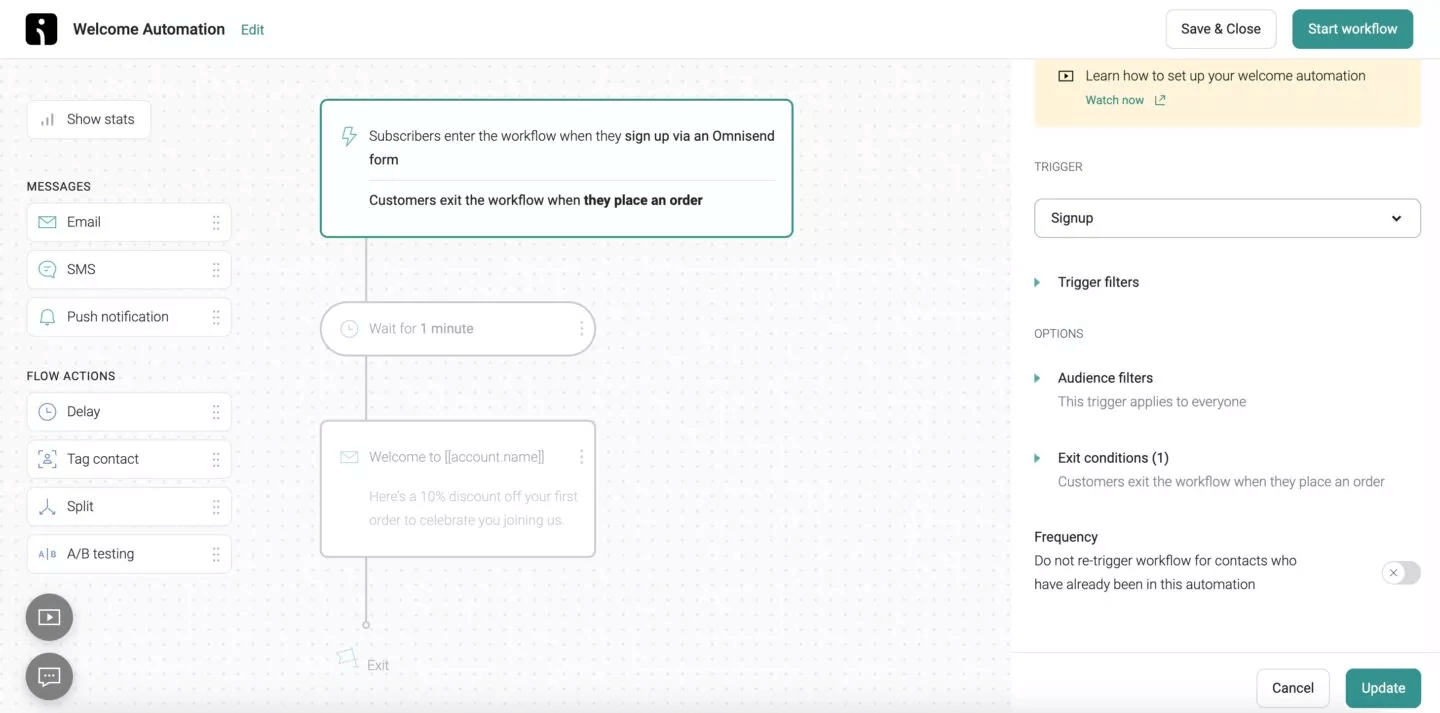
Standout Features
- Prebuilt ecommerce workflows. Automate emails for carts, orders, product reviews, and reactivation out of the box;
- Omnichannel journeys. Run unified campaigns across email, SMS, and push notifications from one dashboard;
- Shopify review automation. Collect reviews post-purchase and showcase them directly on product pages;
- Sales-centric analytics. Measure campaign revenue, engagement, and automation performance in real-time.
Use Cases
Omnisend is perfect for ecommerce brands that want to automate customer journeys and maximize sales. Here are the some use cases that can be beneficial as a business owner:
- Online retailers. Automatically recover abandoned carts with targeted email and SMS marketing;
- Fashion & apparel brands. Boost sales through personalized product recommendations;
- Subscription services. Automate renewal reminders and upselling campaigns across multiple marketing channels.
Our Experience with Omnisend
We tested Omnisend on Shopify and loved the seamlessness. With zero dev effort, we activated welcome emails, cart reminders, and post-purchase sequences within a day. We also added SMS for reactivation campaigns, easily.
Unlike tools where SMS feels bolted on, Omnisend’s workflows made switching between email and text feel natural. We could test variations, see revenue attribution by channel, and optimize without juggling tools.
Pricing
Omnisend starts at $20/month for up to 1,000 contacts and 12,000 emails, and includes a free plan with basic automation. The real value kicks in with the Standard plan, where SMS, push notifications, and advanced reporting unlock.
Omnisend is easy to use, with helpful email and SMS automation, and the templates save time. While design options are a bit limited and costs can rise as your list grows, it’s a solid tool for marketing.
— Dauanie from Capterra
Drip — Tailored Email Campaigns for Ecommerce
Drip brands itself as an ecommerce-first solution and it certainly lives up to the claim. It’s built from the ground up to help online brands build smarter, more personalized automated workflows for boosting revenues.
We tested Drip and found its automation depth both powerful and intuitive. It goes beyond standard triggers—allowing you to target users who viewed a product but didn’t add it to cart, or who purchased after a discount but never returned. These micro-moments matter, and Drip makes them easy to act on.
The visual workflow builder is incredibly flexible. We were able to map customer journeys with tags, filters, and actions in one flow without it getting messy. Plus, the on-site pop ups feature added a powerful top-of-funnel layer.
That said, there’s no free plan or trial, and the learning curve is a bit steeper than beginner tools. But if your store is growing and you’re serious about optimizing every touchpoint, Drip is worth the investment.
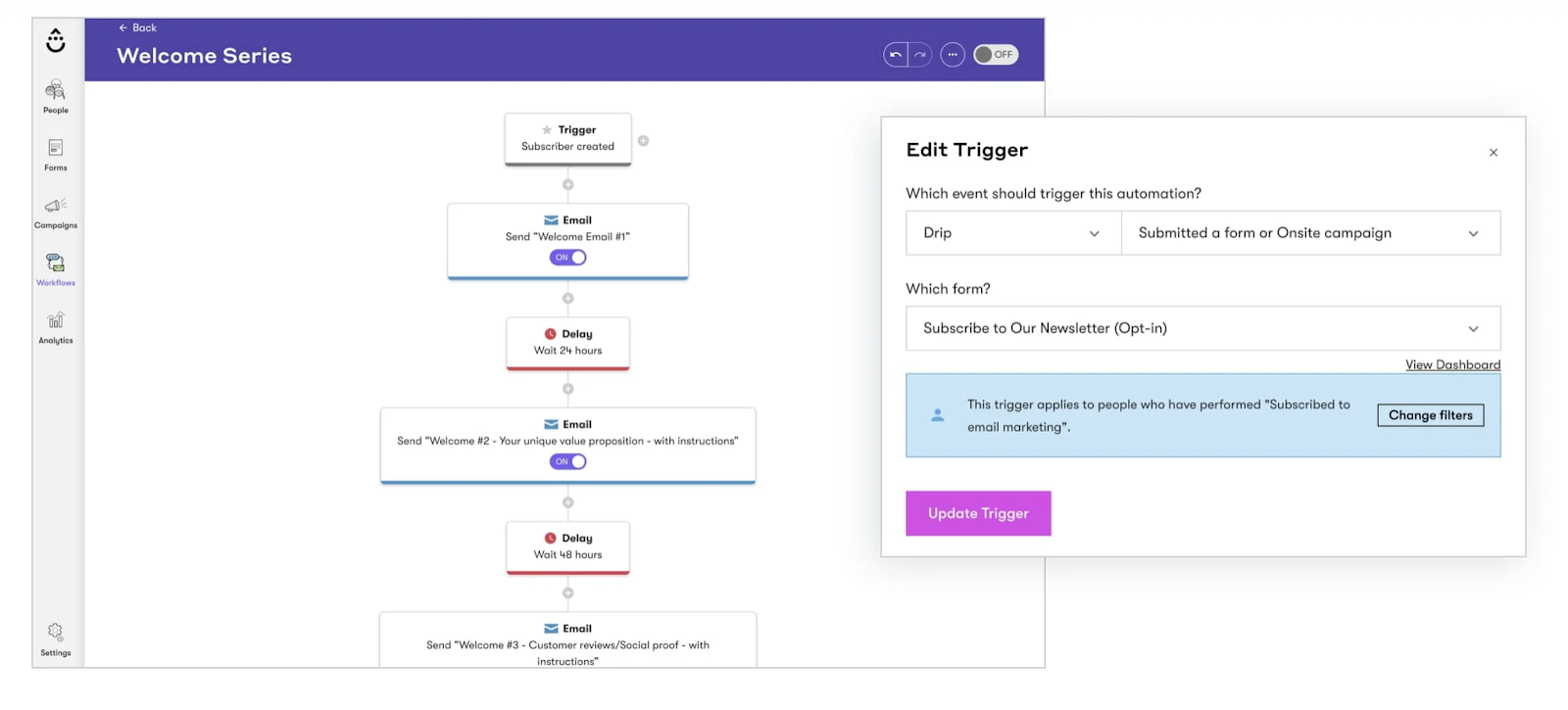
Standout Features
- Advanced workflow builder. Build complex, responsive drip campaigns using tags, delays, and dynamic triggers;
- Precise segmentation rules. Create segments based on customer tags, visit history, or product interactions;
- Event-based automation. Trigger flows from add-to-cart, checkout abandonment, or post-purchase windows.
- Popup & form builder. Capture leads with custom on-site forms that feed directly into automation flows.
Use Cases
Drip is ideal for ecommerce businesses that want to set up hyper-personalized, behavior-based automation. Here are some use cases:
- DTC brands. Send dynamic post-purchase upsells, loyalty offers, and personalized product recommendations;
- Shopify sellers. Send event-triggered emails based on abandoned carts and product page views;
- Niche stores. Segment and nurture leads based on browsing and buying habits.
Our Experience with Drip
We used Drip to build post-purchase flows that recommended newly launched products based on prior orders. We also set up a win-back campaign triggered by 30 days of inactivity. The entire process took us only a couple of hours.
Drip’s real-time revenue tracking is also an interesting offering to understand which emails actually drive sales. This makes it easier to justify optimization tactics and scale winning flows without guesswork.
Pricing
Drip starts at $39/month for up to 2,500 contacts, with unlimited emails. There’s no free plan or trial, so it’s best suited for businesses already running or scaling their ecommerce operations.
Easy to navigate UI, solid visual email builder, prompt live chat service response. Supplied email builder templates are well designed and flexible to utilize for a variety of messaging styles. Continuous improvement of features and implementation of new tools.
— Tom O. from G2
Kit – Best for Creators and Bloggers with Audience Segmentation
Kit (formerly ConvertKit) is built specifically for creators who want to build meaningful connections with their audience. It’s a lightweight but smart email automation platform for bloggers, solopreneurs, and creators who want to segment, personalize, and monetize their audience.
User Experience Ratings:
- Capterra: 4.7 /5.0
- Trustpilot: 2.7/5.0
- G2: 4.4 /5.0

We’ve used Kit before and like its tag-based segmentation system. It doesn’t try to force you into ‘lists’—instead, you assign tags based on behavior or preferences. This simplifies your personalization efforts.
What also works well is how Kit blends monetization and email under one roof. You can sell a product, collect payment, and trigger delivery emails—all without needing Zapier or an extra checkout tool.
It’s a great solution if you want to automate delivery of a free guide, launch a paid newsletter, or sell a digital product.
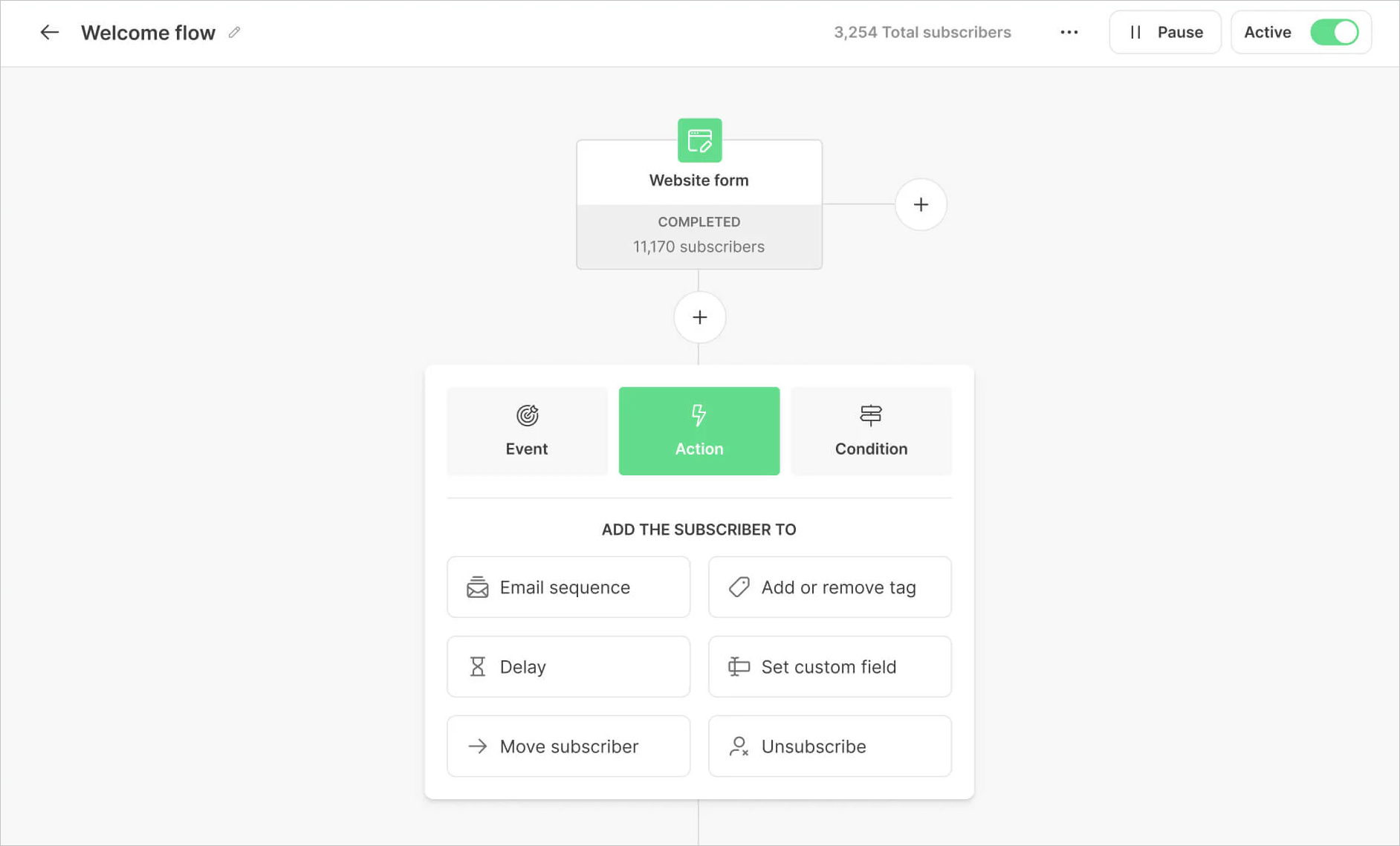
Standout Features
- Visual automation builder. Easily map out lead magnets, email sequences, and content delivery flows;
- Smart tagging system. Segment based on clicks, purchases, sign-ups, or topic interest;
- Conditional content blocks. Show or hide email sections depending on reader behavior or profile;
- Monetization tools. Sell digital products or subscriptions directly through your emails or landing pages.
Use Cases
Kit is designed for creators looking to grow, engage, and monetize their audience through automation. Here are some potential applications for a creator looking to engage their audience:
- Bloggers. Send targeted content based on reader interest and previous engagement;
- Online educators. Automate course delivery, follow-ups, and upsells to paid content;
- Newsletter writers. Segment readers for premium content and automate subscription flows.
Our Experience with Kit
We created a free sequence with a digital guide as a lead magnet, followed by a timed upsell to the paid tier. The UI and the setup process was smooth. There was everything we needed—payments, tagging, and segmentation in the dashboard.
Though the email editor has no flashy design blocks, it felt lean. It is perfect for text-heavy content but not the best for a visual email. Its creator network was something unique we noticed to cross-promote offers with other similar creators.
Pricing
Kit starts at $25/month for 1,000 subscribers and unlimited emails. There’s also a free plan that includes basic automation, forms, and broadcast emails. It’s real value is in the monetization features it offers on the paid plans. You can sell digital products, set up paid newsletters, and offer content upgrades.
Kit does a great job at making things simple. The UI is easy to navigate, and templates are easy to set up and implement. Automations are also very easy to set up with a visual interface.
— Dustin from Capterra
Klaviyo — Data-Driven Ecommerce Email Automation
Klaviyo is built for ecommerce brands that want to do more than sending automated emails. With tight integrations (especially with Shopify) and rich automation capabilities, Klaviyo helps you engage the right customers at the right time to drive revenue.
User Experience Ratings:
- Capterra: 4.6 /5.0
- Trustpilot: 2.3/ 5.0
- G2: 4.6 /5.0

We’ve tested Klaviyo for a Shopify store and found the deep customer insights truly helpful. Every click, browse, and purchase feeds into Klaviyo’s automation engine, helping you create flows that feel highly personalized, even with large lists.
In one instance, we set up a post-purchase flow that changed based on cart value and purchase history. Customers who bought once received a reorder incentive; repeat buyers were nudged toward a subscription.
Klaviyo’s AI-driven tools also impressed us. You can forecast churn, generate personalized subject lines, and even adjust email timing based on predicted buying behavior. But be warned, it’s not as beginner-friendly as some platforms.
You’ll get the most value if you already understand ecommerce data and segmentation strategy.
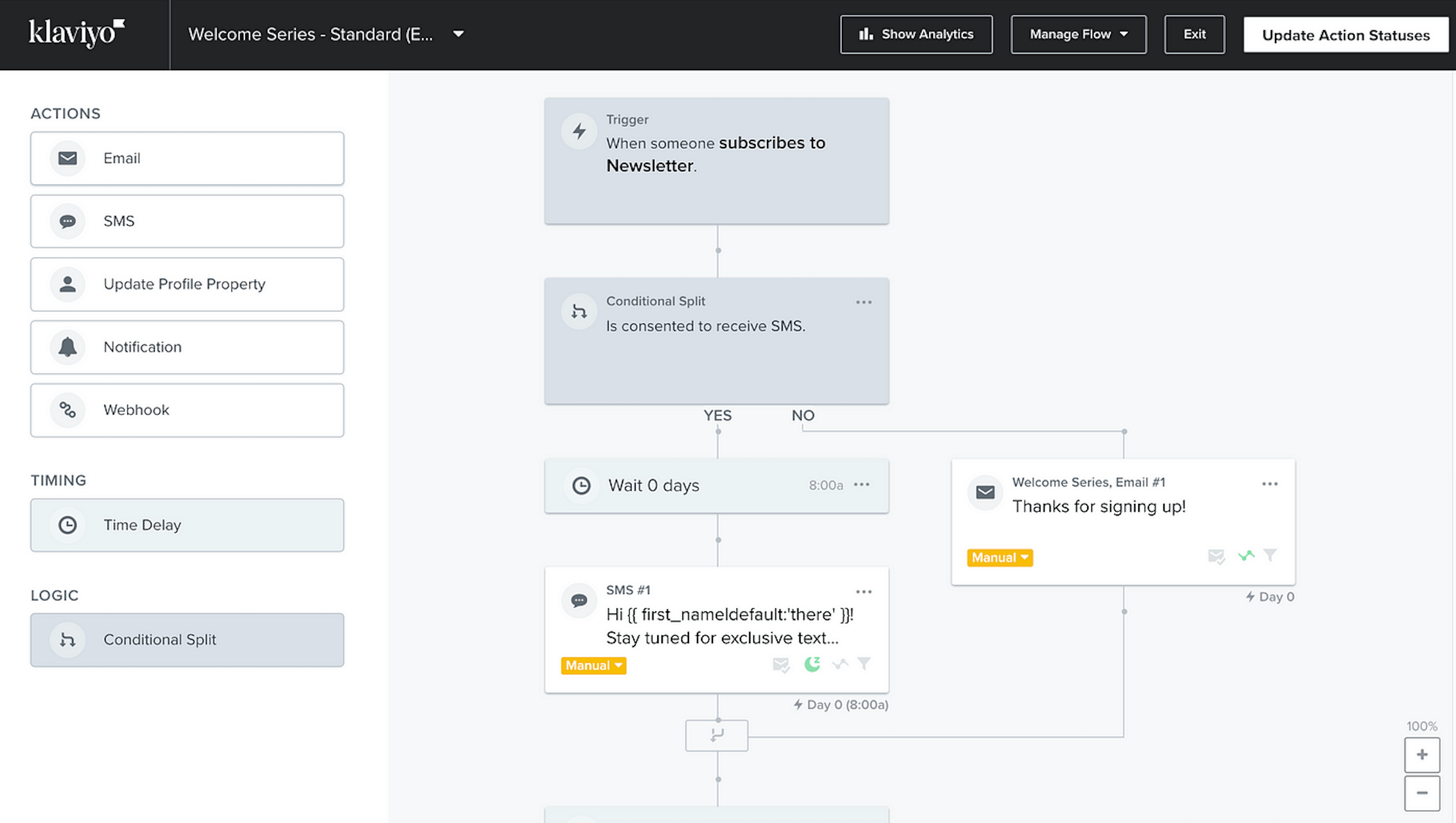
Standout Features
- Behavior-based triggers. Automate flows from browsing, purchases, cart events, and inactivity data;
- Custom product recommendations. Use dynamic blocks to recommend items based on real-time shopping behavior;
- Revenue attribution engine: Track the exact revenue each email or SMS generates across channels;
- Unified CRM & marketing dashboard. Combine email, SMS, segmentation, and customer data in one dashboard.
Use Cases
Klaviyo is best suited for ecommerce businesses that want data-backed automation and a unified interface to managing everything from a single dashboard. Here are some applications:
- Shopify sellers. Automate product recommendations, recovery emails, and customer retention emails;
- DTC brands. Use AI-driven behavior data to trigger personalized, high-converting campaigns;
- Subscription box businesses. Automate reorder reminders and loyalty sequences based on customer behavior.
Our Experience with Klaviyo
We worked on a Klaviyo setup for a test store with thousands of SKUs. Using product-specific triggers and repeat behavior tracking, we created campaigns that recommended contextual upsells, right after first purchase.
Another thing we loved? Klaviyo’s analytics. It didn’t just show opens and clicks—it told us how much revenue came from each automation. That kind of clarity made it easier to justify testing, iterate fast, and prioritize campaigns that made a real impact.
Pricing
Klaviyo starts at $30/month for 1,000 subscribers and 10,000 emails. There’s a free plan that includes limited automations, but it’s just for testing purposes.
The real power is unlocked with a paid plan. With built-in SMS, predictive AI, and revenue reporting, Klaviyo’s pricing makes sense for scaleups ready to get serious about data-backed growth.
Klaviyo is an excellent tool for our email campaigns, offering seamless integration with Shopify and powerful segmentation features. The intuitive interface allows us to create automated flows easily, helping us target our audience effectively and drive conversions. Highly recommended!
— Shayne from Capterra
Postmark — Reliable and Fast Transactional Email Delivery
Postmark isn’t for flashy campaigns or visual-heavy newsletters, but its a transactional email service built for speed and. From password resets to order confirmations, it ensures time-sensitive messages land in inboxes immediately, not minutes (or hours) later.
User Experience Ratings:
- Capterra: 4.8 /5
- Trustpilot: 2.4 /5
- G2: 4.6 /5

During our tests with Postmark, we saw it outperforming generic platforms when it came to delivery speed and inbox placement. Setup was straightforward and the API documentation was one of the cleanest we’ve tested.
Its reputation for high deliverability ensures that time-sensitive emails don’t end up in spam folders. And with real-time reporting, we could track every email event to ensure nothing was slipping through.
Another feature we liked was its templating engine. While basic, it’s built for speed and clarity. You can create custom templates and reuse them across events without touching your app’s backend.

Standout Features
- Real-time delivery reports. Start monitoring email status across opens, clicks, and delivery within seconds;
- API-first architecture. Easily integrate with your app or store using clear, well-documented endpoints;
- Signature setup. Customize sender names, domains, and IPs for each type of message;
- Secure SMTP support. Get started without heavy developer help using basic yet powerful SMTP credentials.
Use Cases
Postmark is built for businesses that need a reliable and quick way for transactional email automation. Here are the top use cases for Postmark:
- SaaS platforms. Instantly send password resets, account creation alerts and login updates;
- Ecommerce stores. Automate order confirmations, shipping notifications, invoices, and payment receipts;
- Fintech startups. Ensure timely delivery of OTPs, invoices, and payment alerts.
Our Experience with Postmark
We tested Postmark for a fintech scenario where we noticed some delivery issues with a generic ESP. The difference was immediate—OTP emails that used to take 40–60 seconds were now delivered in under 5.
A feature we liked while testing was the segmented message streams, which helped separate transactional and promotional sends. If you’re sending high-volume transactional emails, Postmark’s reliability isn’t just helpful, its essential.
Pricing
Postmark starts at $15/month for up to 10,000 emails and offers a free trial. It’s priced based on usage, not contact list size, which makes it cost-efficient for apps or platforms sending high volumes of critical messages.
It’s a great SMTP provider that is easy to set up as well as great delivery and clean IPs. On top of that, it also has a DMARC reporting tool which I like and recommend to any beginner or non-techy person out there. Support is great and quick to reply to any issues you might have.
— Dame from G2
Constant Contact — Effective Scheduled Email Management
If you want a no-fuss platform to plan and send emails like clockwork, Constant Contact gets the job done. It’s especially useful for local businesses, nonprofits, and retail stores looking to schedule newsletters or promotions without complicated flows.
User Experience Ratings:
- Capterra: 4.3 /5.0
- Trustpilot: 4.4 /5.0
- G2: 4.0 /5.0
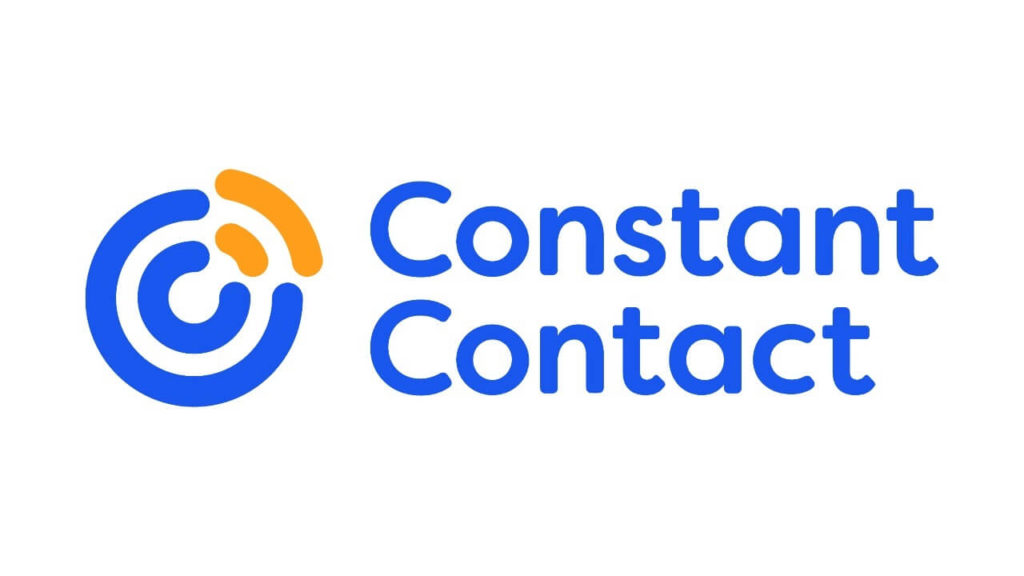
Constant Contact’s biggest strength is its simplicity. You can pick a date and time, choose a template, write your content, and schedule it for the future.
In one scenario, we used Constant Contact to automate a monthly newsletter. The setup was done in a few hours, and we were able to build a consistent calendar. The built-in analytics will help tweak send times for higher open rates.
Another pleasant surprise was the social media dashboard. It’s not a full-on management suite, but it allows you to schedule posts alongside email campaigns, helpful when you’re managing everything solo.
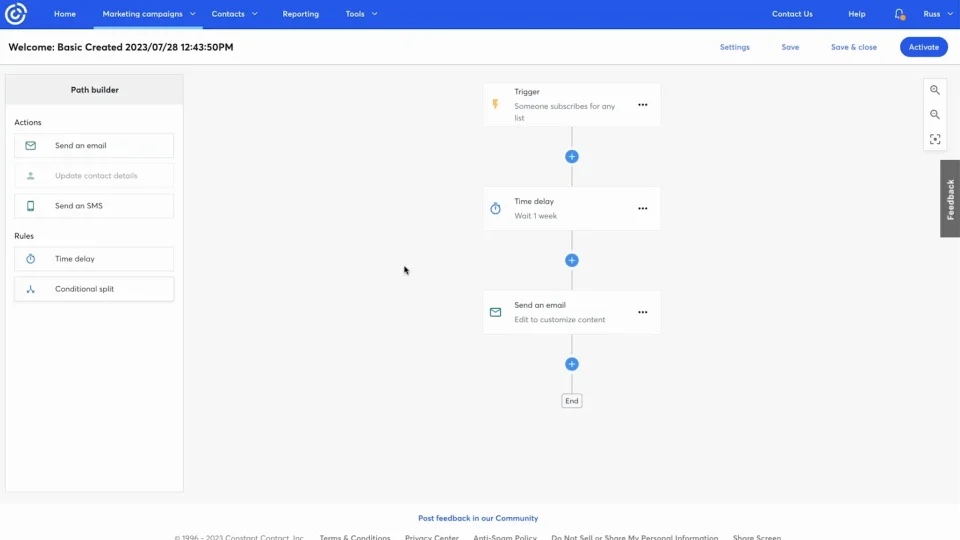
Standout Features
- Email scheduling tools. Automate campaigns based on send time, audience behavior, or planned promotions;
- AI assistant. Write or fine-tune subject lines and body copy with built-in generative AI tools;
- List segmentation tools. Organize subscribers into groups for targeted outreach or recurring sends;
- Event marketing suite. Promote, invite, and follow up on events using integrated event registration tools.
Use Cases
Constant Contact is good for brands that want a simple way to schedule emails and set up automation. Here are some applications:
- Local businesses. Keep customers in the loop with weekly offers or monthly business updates.
- Nonprofits. Send donation drives, event invites, and thank-you follow-ups with minimal effort.
- Retail stores. Schedule seasonal product launches and sale announcements without needing an automation expert.
Our Experience with Constant Contact
We tried Constant Contact to set up a quarterly donation campaign with a monthly newsletter for a hypothetical nonprofit. The drag-and-drop editor, paired with a solid template library, made it easy to get a professional look without a designer. And with event integration, RSVPs and follow-ups were automatically handled inside the platform.
We also tested its social media planner to coordinate Facebook posts with email announcements and it worked well to bring additional traffic.
Pricing
Constant Contact starts at $30/month for 1,000 subscribers and 10,000 emails. A free plan is also available. It’s not the most advanced automation tool, but it’s a dependable option if you want something to begin. Great for businesses that value peace of mind and predictable scheduling over marketing complexity.
Constant Contact has been very useful for e-news, event, and fundraising communication. For the most part the platform is user friendly and intuitive to use. It’s important to keep an eye on the number of contacts in your system and remove any outdated ones because Constant Contact bills by the number of contacts in your account.
— Allyson from Capterra
FAQs about Email automation software
Why do you need email automation?
Email automation helps you engage the right people at the right time, without manual work. It saves hours by sending timely, personalized emails based on user behavior (like sign-ups, purchases, or inactivity). Email automation improves consistency, boosts conversions, and frees up your time to focus on email marketing strategy, and not repetitive tasks.
What features should I look for in an email automation tool?
Look for features like visual automation builders, segmentation, dynamic personalization, A/B testing, and performance tracking when evaluating the best email automation tools. Integration with your CRM tools and/or ecommerce platforms is also essential if you’re aiming for scalability using email marketing automation services. You can also look at an open source email marketing automation solution if you want to self-host, want more control over your data or costs.
Can small businesses benefit from email automation?
Absolutely. Even basic automation, like welcome emails, birthday offers, or cart reminders, can make a huge difference. It helps small businesses stay connected with customers, look professional, and drive more revenue with minimal effort.
What’s the ideal length for an email sequence?
Most high-performing email sequences fall between 4 and 7 emails, though the ideal length depends on your goal and stage in the funnel. A lead nurture flow may span 5 emails over 10 days, while a post-purchase sequence could be shorter.
The key is value over volume. Each email should serve a clear purpose, build trust, and move the reader forward, without repeating yourself or overwhelming them.
